
AzuraCast is a self-hosted, all-in-one web radio management suite. Using its easy installer and powerful, but intuitive web interface, you can start up a fully working web radio station in a few quick minutes. AzuraCast works for web radio stations of all types and sizes, and is built to run on every NAS device. In this step by step guide I will show you how to install AzuraCast on your Synology NAS using Docker & Portainer.
This guide works perfectly with the latest AzuraCast v0.21.0 release.
STEP 1
Please Support My work by Making a Donation.
STEP 2
Install Portainer using my step by step guide. If you already have Portainer installed on your Synology NAS, skip this STEP. Attention: Make sure you have installed the latest Portainer version.
STEP 3
Make sure you have a synology.me Wildcard Certificate. Follow my guide to get a Wildcard Certificate. If you already have a synology.me Wildcard certificate, skip this STEP.
STEP 4
Go to Control Panel / Login Portal / Advanced Tab / click Reverse Proxy. Follow the instructions in the image below.
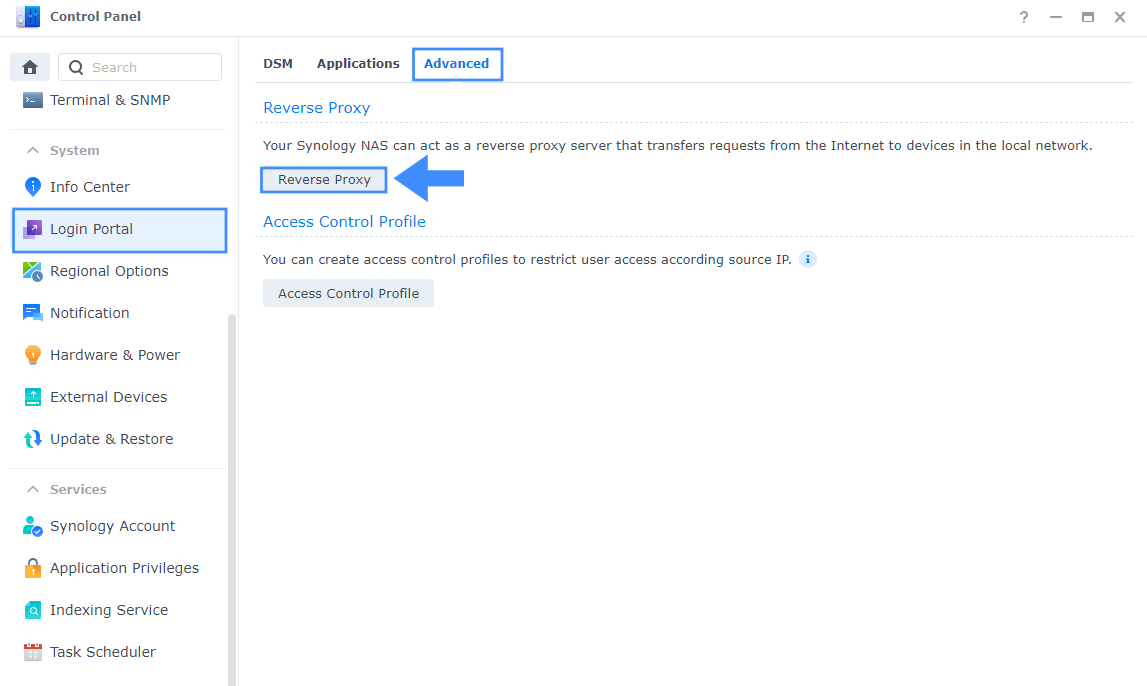
STEP 5
Now click the “Create” button. Follow the instructions in the image below.
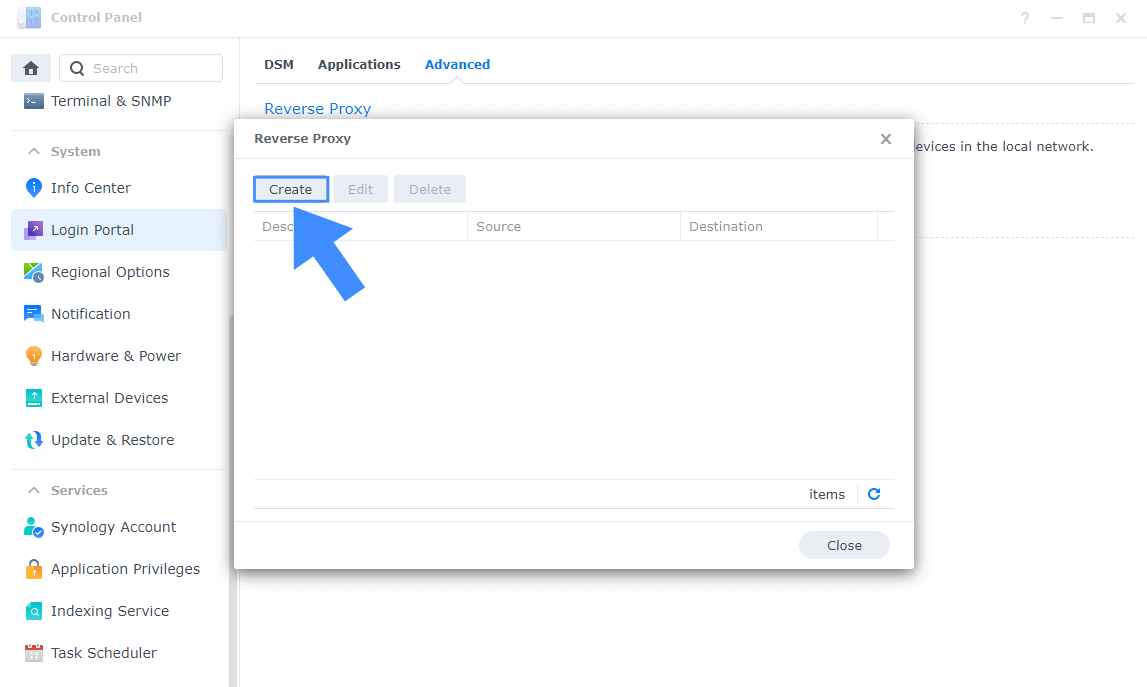
STEP 6
After you click the Create button, the window below will open. Follow the instructions in the image below.
On the General area, set the Reverse Proxy Name description: type in AzuraCast. After that, add the following instructions:
Source:
Protocol: HTTPS
Hostname: azuracast.yourname.synology.me
Port: 443
Check Enable HSTS
Destination:
Protocol: HTTP
Hostname: localhost
Port: 8421
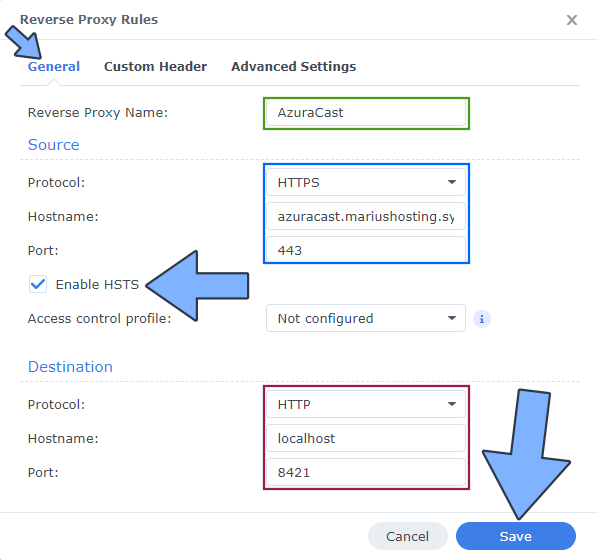
STEP 7
On the Reverse Proxy Rules click the Custom Header tab. Click Create and then, from the drop-down menu, click WebSocket. After you click on WebSocket, two Header Names and two Values will be automatically added. Click Save. Follow the instructions in the image below.

STEP 8
Go to Control Panel / Network / Connectivity tab/ Check Enable HTTP/2 then click Apply. Follow the instructions in the image below.
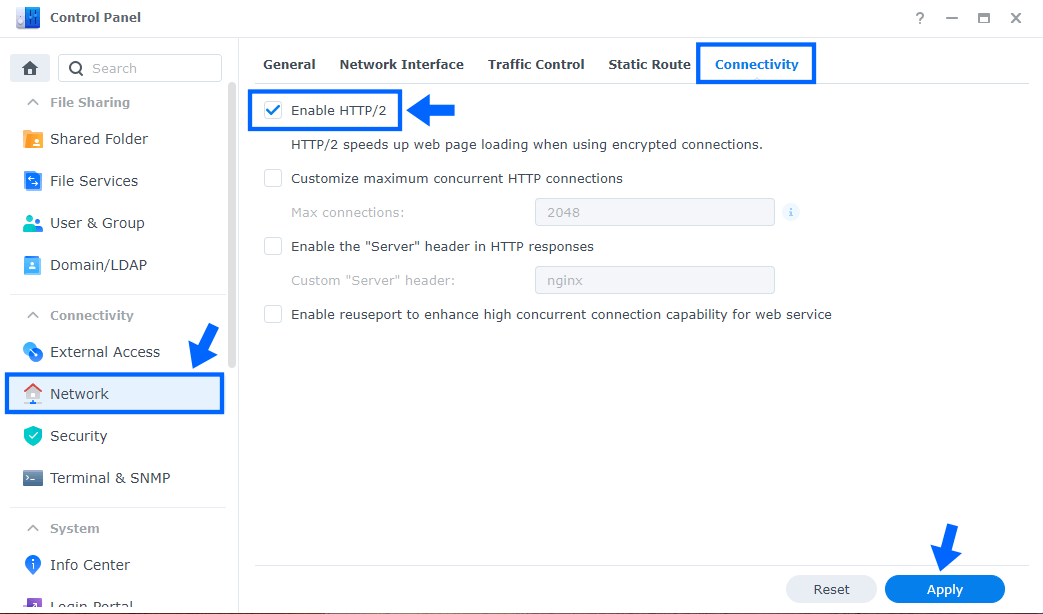
STEP 9
Go to Control Panel / Security / Advanced tab/ Check Enable HTTP Compression then click Apply. Follow the instructions in the image below.
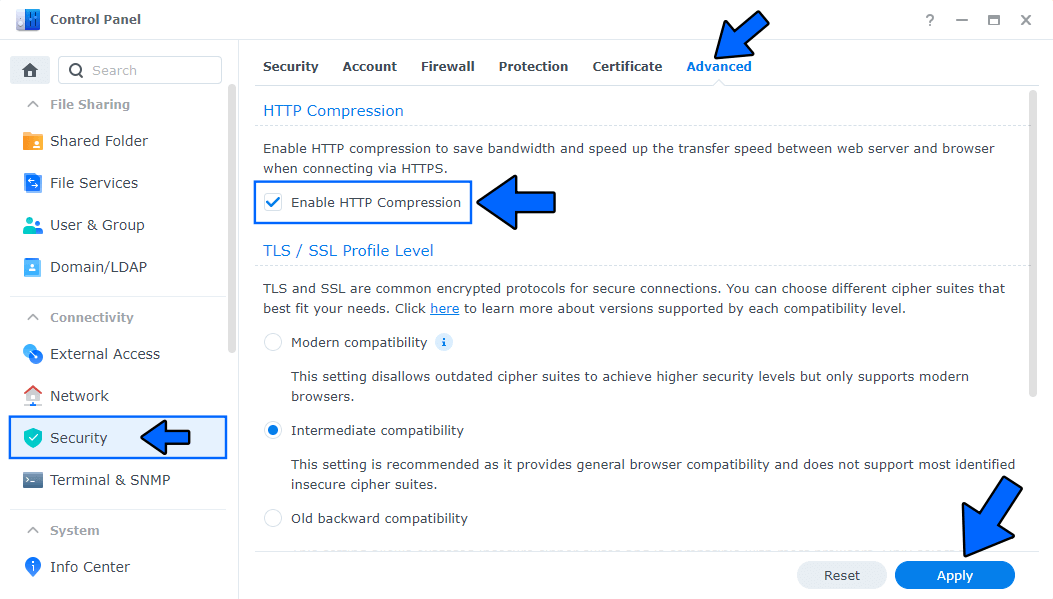
STEP 10
Go to File Station and open the docker folder. Inside the docker folder, create one new folder and name it azuracast. Follow the instructions in the image below.
Note: Be careful to enter only lowercase, not uppercase letters.
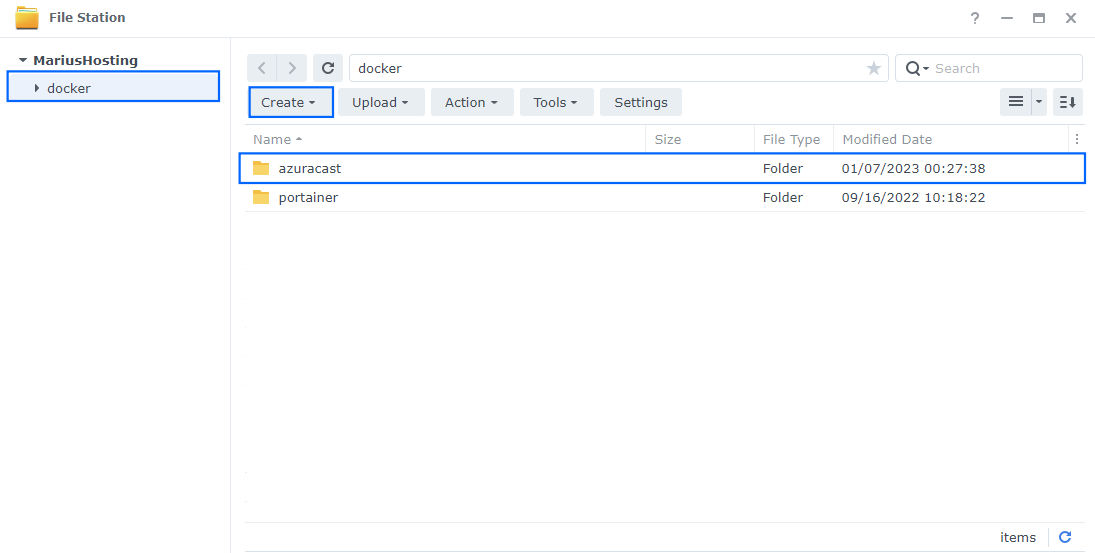
STEP 11
Now create eleven new folders inside the azuracast folder that you created at STEP 10 and name them acme, backups, dbconfig, dbmysql, geoip, persist, redis, shoutcast, stations, stereo, uploads. Follow the instructions in the image below.
Note: Be careful to enter only lowercase, not uppercase letters.
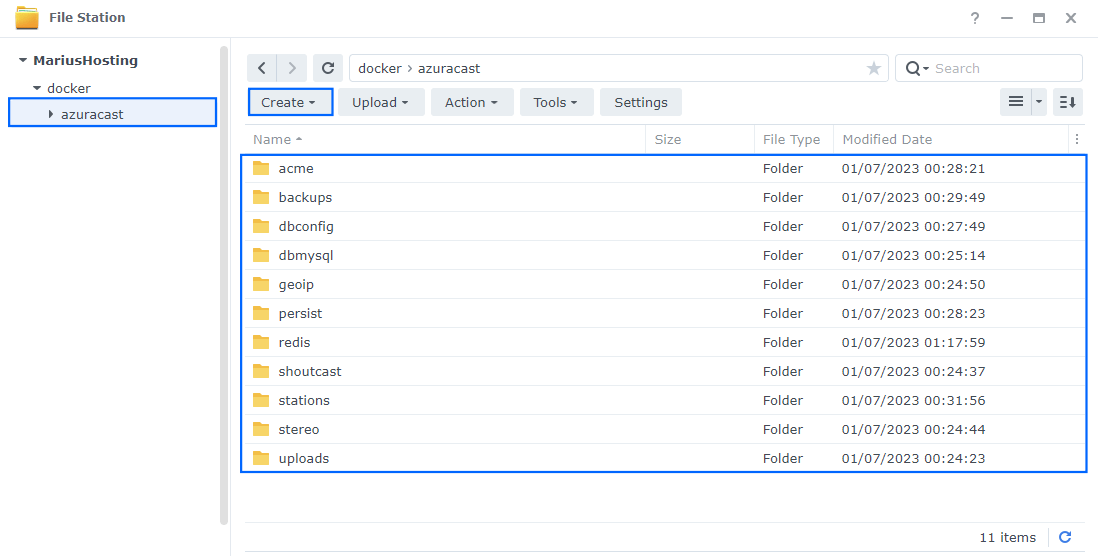
STEP 12
Log into Portainer using your username and password. On the left sidebar in Portainer, click on Stacks then + Add stack. Follow the instructions in the image below.

STEP 13
In the Name field type in azuracast. Follow the instructions in the image below.
services:
azuracast-redis:
image: redis
container_name: AzuraCast-REDIS
hostname: azuracast-redis
security_opt:
- no-new-privileges:true
healthcheck:
test: ["CMD-SHELL", "redis-cli ping || exit 1"]
user: 1026:100
environment:
TZ: Europe/Bucharest
volumes:
- /volume1/docker/azuracast/redis:/data:rw
restart: on-failure:5
azuracast-db:
image: mariadb:11.4-noble #LTS Long Time Support Until May 29, 2029.
container_name: AzuraCast-DB
hostname: azuracast-db
security_opt:
- no-new-privileges:false
environment:
TZ: Europe/Bucharest
MYSQL_ROOT_PASSWORD: azuracastrootpw
MYSQL_DATABASE: azuracast
MYSQL_USER: azuracastuser
MYSQL_PASSWORD: azuracastpw
MYSQL_SLOW_QUERY_LOG: 0
MYSQL_MAX_CONNECTIONS: 100
volumes:
- /volume1/docker/azuracast/dbconfig:/var/lib/mysql:rw
restart: on-failure:5
azuracast:
image: azuracast/azuracast:latest
container_name: AzuraCast
hostname: azuracast
security_opt:
- no-new-privileges:false
ulimits:
nofile:
soft: 65536
hard: 65536
logging:
options:
max-size: "1m"
max-file: "5"
healthcheck:
test: timeout 10s bash -c ':> /dev/tcp/127.0.0.1/80' || exit 1
interval: 10s
timeout: 5s
retries: 3
start_period: 90s
ports:
- 8421:80
- 8111:8000
- 8119:8005
- 8113:8006
- 8114:8010
- 8115:8015
- 8116:8016
- 8117:8020
environment:
APPLICATION_ENV: production
MYSQL_HOST: azuracast-db
MYSQL_PORT: 3306
MYSQL_USER: azuracastuser
MYSQL_PASSWORD: azuracastpw
MYSQL_DATABASE: azuracast
ENABLE_REDIS: true
REDIS_HOST: azuracast-redis
REDIS_PORT: 6379
REDIS_DB: 1
PROFILING_EXTENSION_HTTP_IP_WHITELIST: "*"
TZ: Europe/Bucharest
PUID: 1026
PGID: 100
volumes:
- /volume1/docker/azuracast/uploads:/var/azuracast/storage/uploads:rw
- /volume1/docker/azuracast/stations:/var/azuracast/stations:rw
- /volume1/docker/azuracast/shoutcast:/var/azuracast/storage/shoutcast2:rw
- /volume1/docker/azuracast/stereo:/var/azuracast/storage/stereo_tool:rw
- /volume1/docker/azuracast/geoip:/var/azuracast/storage/geoip:rw
- /volume1/docker/azuracast/persist:/var/azuracast/storage/sftpgo:rw
- /volume1/docker/azuracast/backups:/var/azuracast/backups:rw
- /volume1/docker/azuracast/acme:/var/azuracast/storage/acme:rw
- /volume1/docker/azuracast/dbmysql:/var/lib/mysql:rw
restart: on-failure:5
depends_on:
azuracast-redis:
condition: service_healthy
azuracast-db:
condition: service_started
Note: Before you paste the code above in the Web editor area below, change the value numbers for user with your own UID and GID values. (Follow my step by step guide on how to do this.) 1026 is my personal UID value and 100 is my personal GID value. You have to type in your own values.
Note: Before you paste the code above in the Web editor area below, change the value for TZ. (Select your current Time Zone from this list.)
Note: Before you paste the code above in the Web editor area below, change the value numbers for PUID and PGID with your own values. (Follow my step by step guide on how to do this.) 1026 is my personal PUID value and 100 is my personal PGID value. You have to type in your own values.
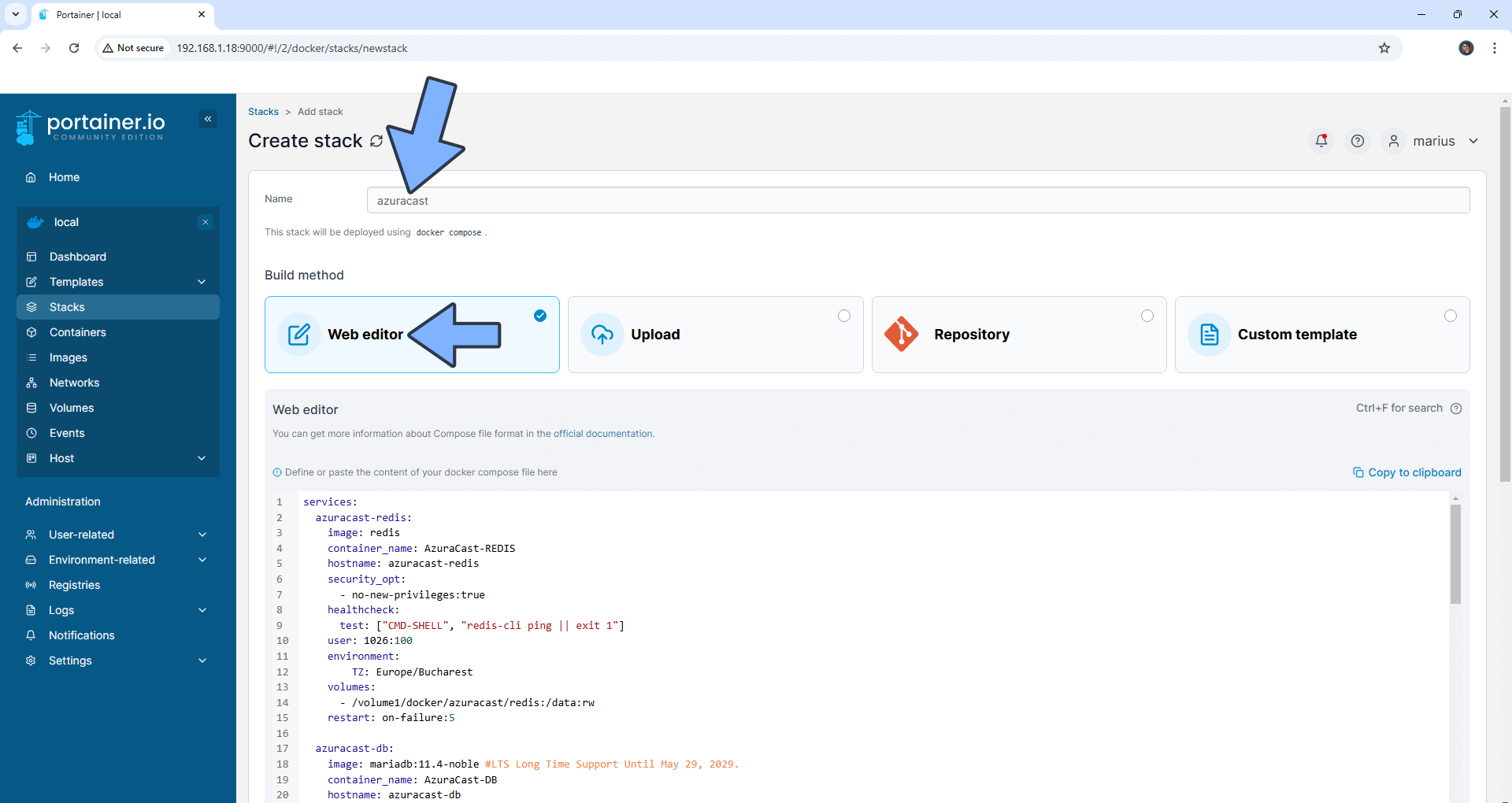
STEP 14
Scroll down on the page until you see a button named Deploy the stack. Click on it. Follow the instructions in the image below. The installation process can take up to a few minutes. It will depend on your Internet speed connection.
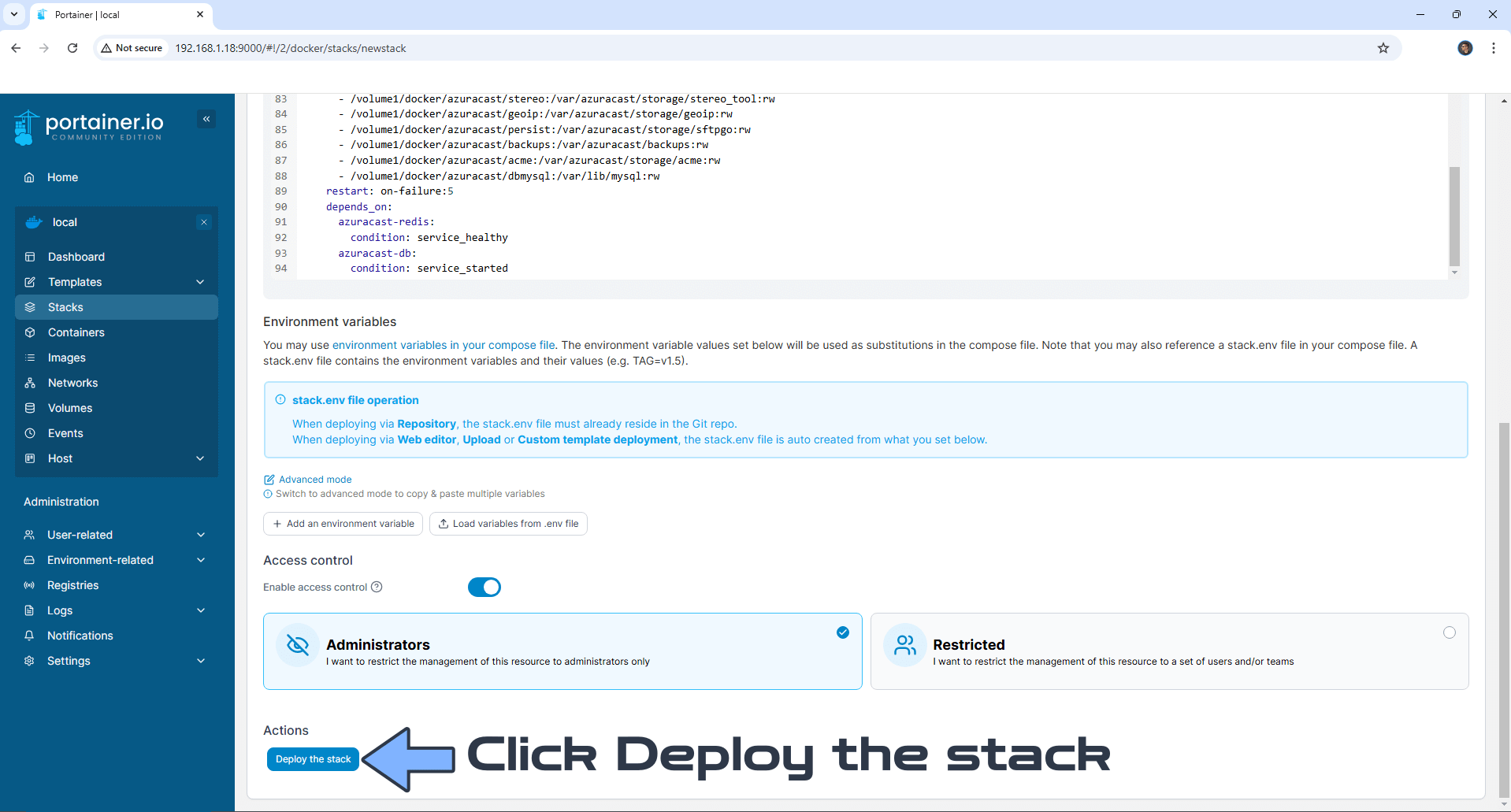
STEP 15
If everything goes right, you will see the following message at the top right of your screen: “Success Stack successfully deployed“.
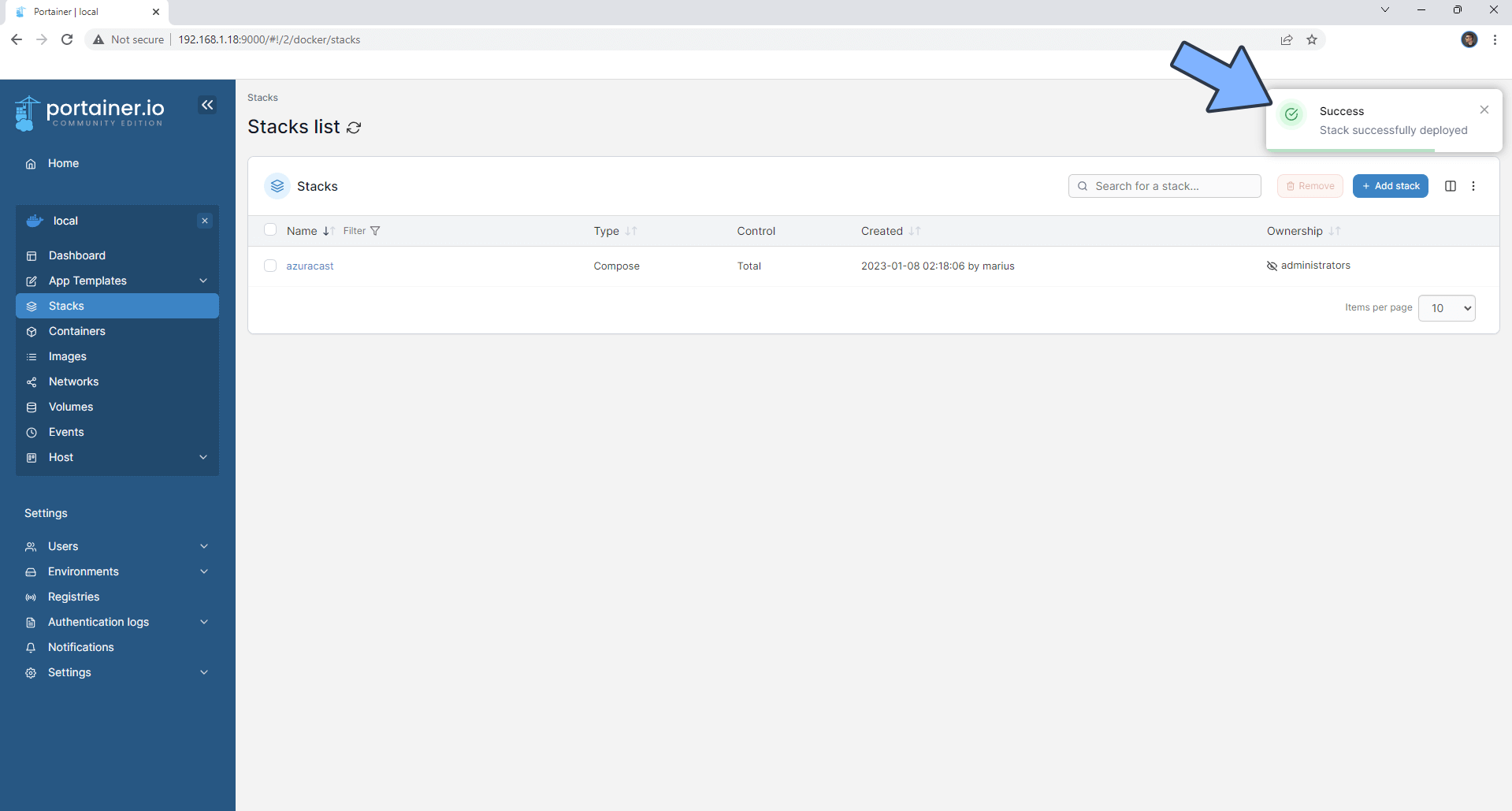
STEP 16
🟢Please Support My work by Making a Donation. Almost 99,9% of the people that install something using my guides forget to support my work, or just ignore STEP 1. I’ve been very honest about this aspect of my work since the beginning: I don’t run any ADS, I don’t require subscriptions, paid or otherwise, I don’t collect IPs, emails, and I don’t have any referral links from Amazon or other merchants. I also don’t have any POP-UPs or COOKIES. I have repeatedly been told over the years how much I have contributed to the community. It’s something I love doing and have been honest about my passion since the beginning. But I also Need The Community to Support me Back to be able to continue doing this work.
STEP 17
Please wait approximately 5-10 minutes for the installation to be completed or you will get a blank page if you try to connect too soon. Now open your browser and type in your HTTPS/SSL certificate that you have previously created at STEP 6. https://azuracast.yourname.synology.me In my case it’s https://azuracast.mariushosting.synology.me If everything goes right, you will see the AzuraCast Setup page. Type in your own Email and your own Password then click CREATE ACCOUNT. Follow the instructions in the image below.
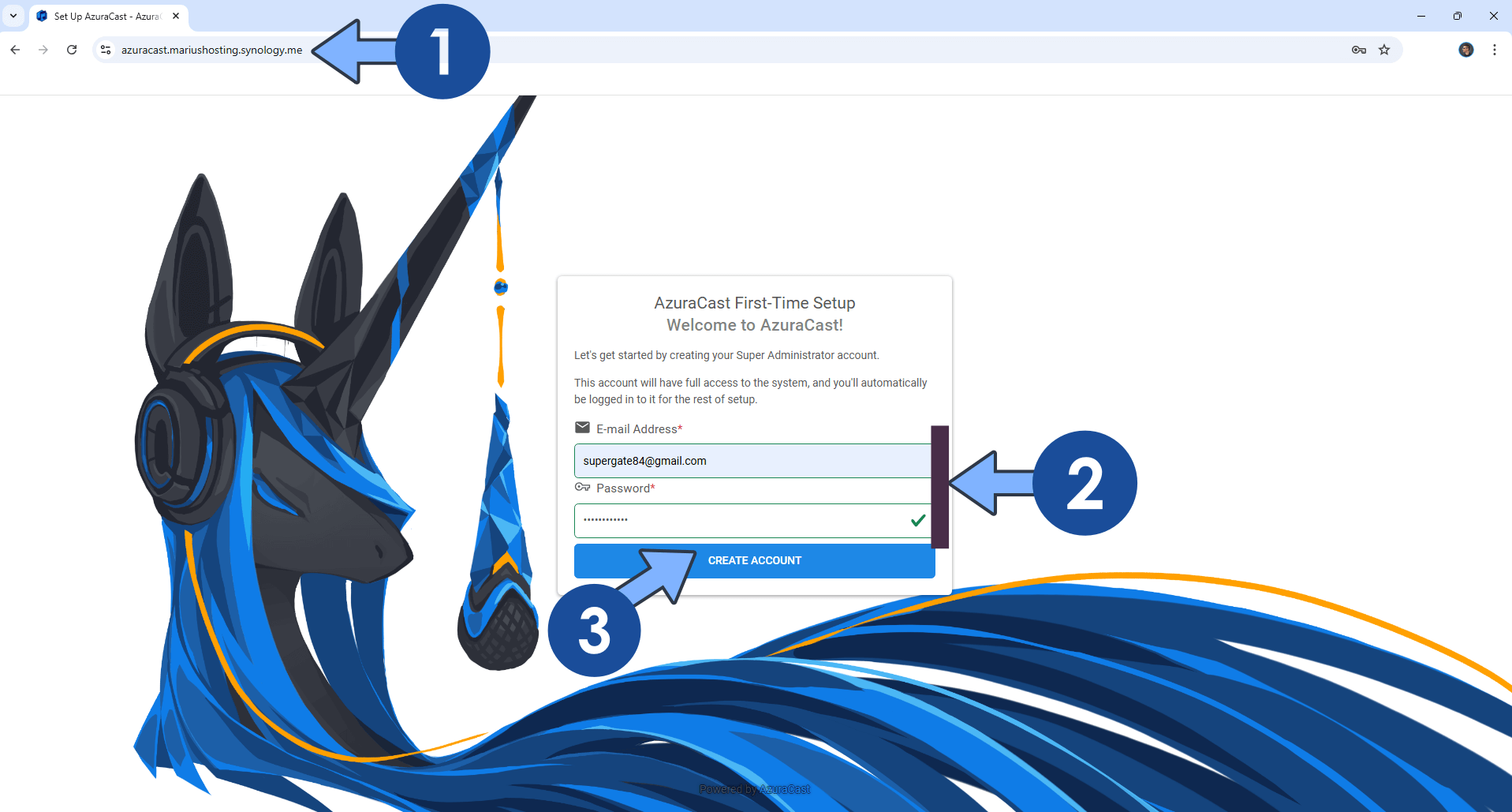
STEP 18
Add your first Radio Station. Give it a Name and a Description. Complete the other information like Genre, Web Site URL, Time zone, etc. Scroll down the page. Follow the instructions in the image below.
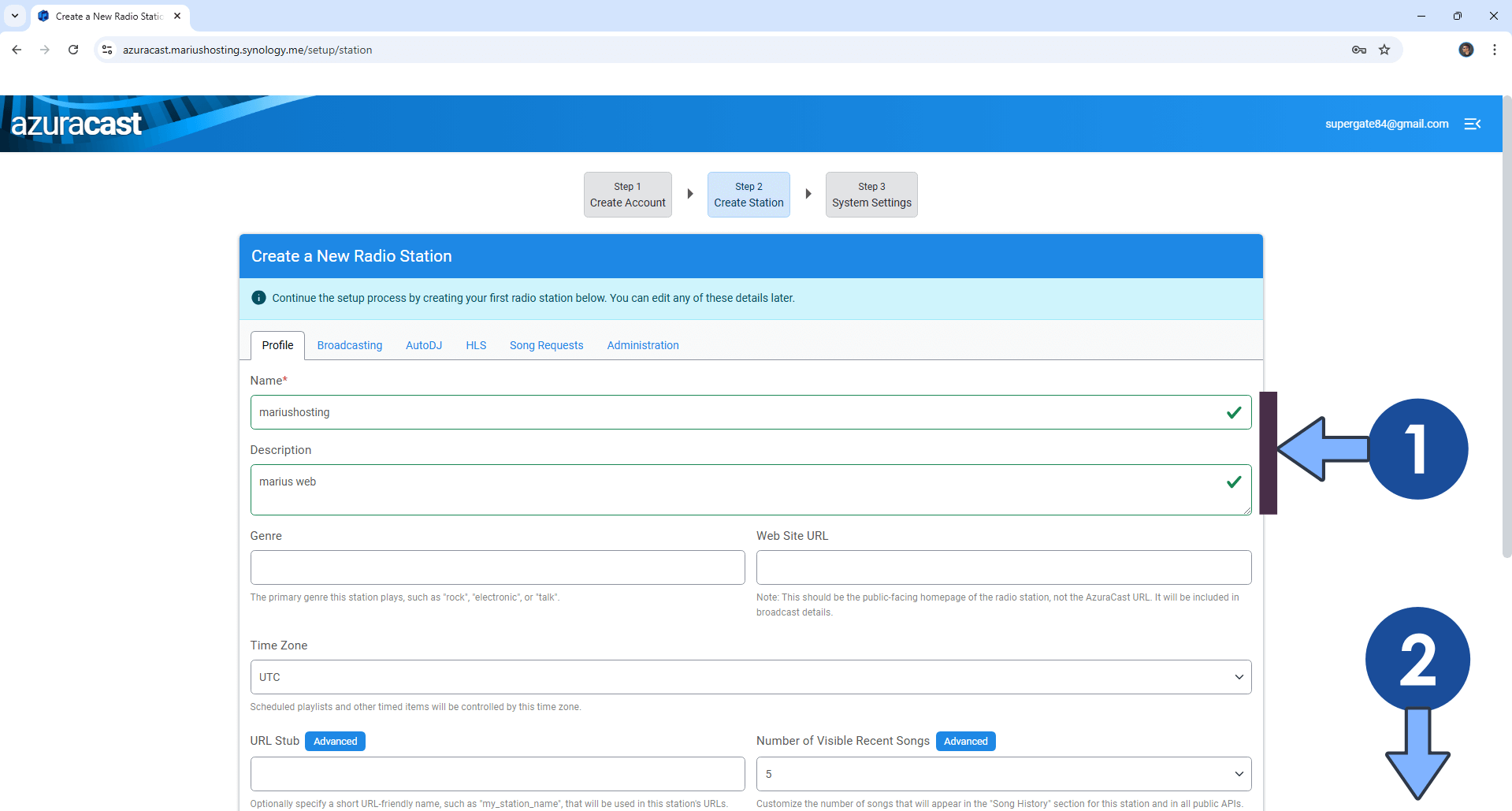
STEP 19
Check Enable Public Pages. Check Enable On-Demand Streaming. Check Enable Downloads on On-Demand Page. Click CREATE AND CONTINUE. Follow the instructions in the image below.
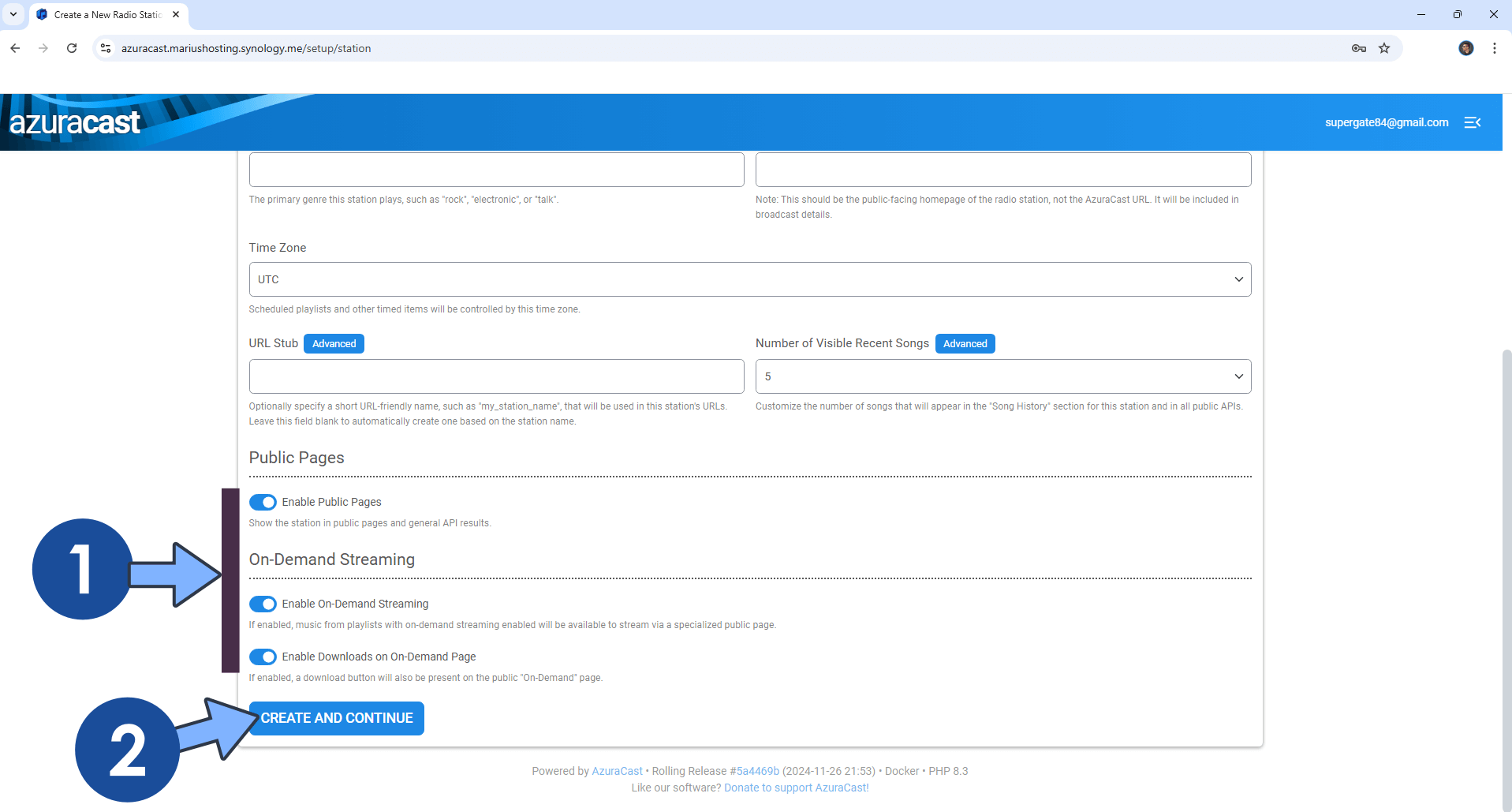
STEP 20
At the top right of the page, click on the menu icon, then select Switch Theme for Dark Mode. Click the ADMINISTRATION option for the AzuraCast settings. Follow the instructions in the image below.
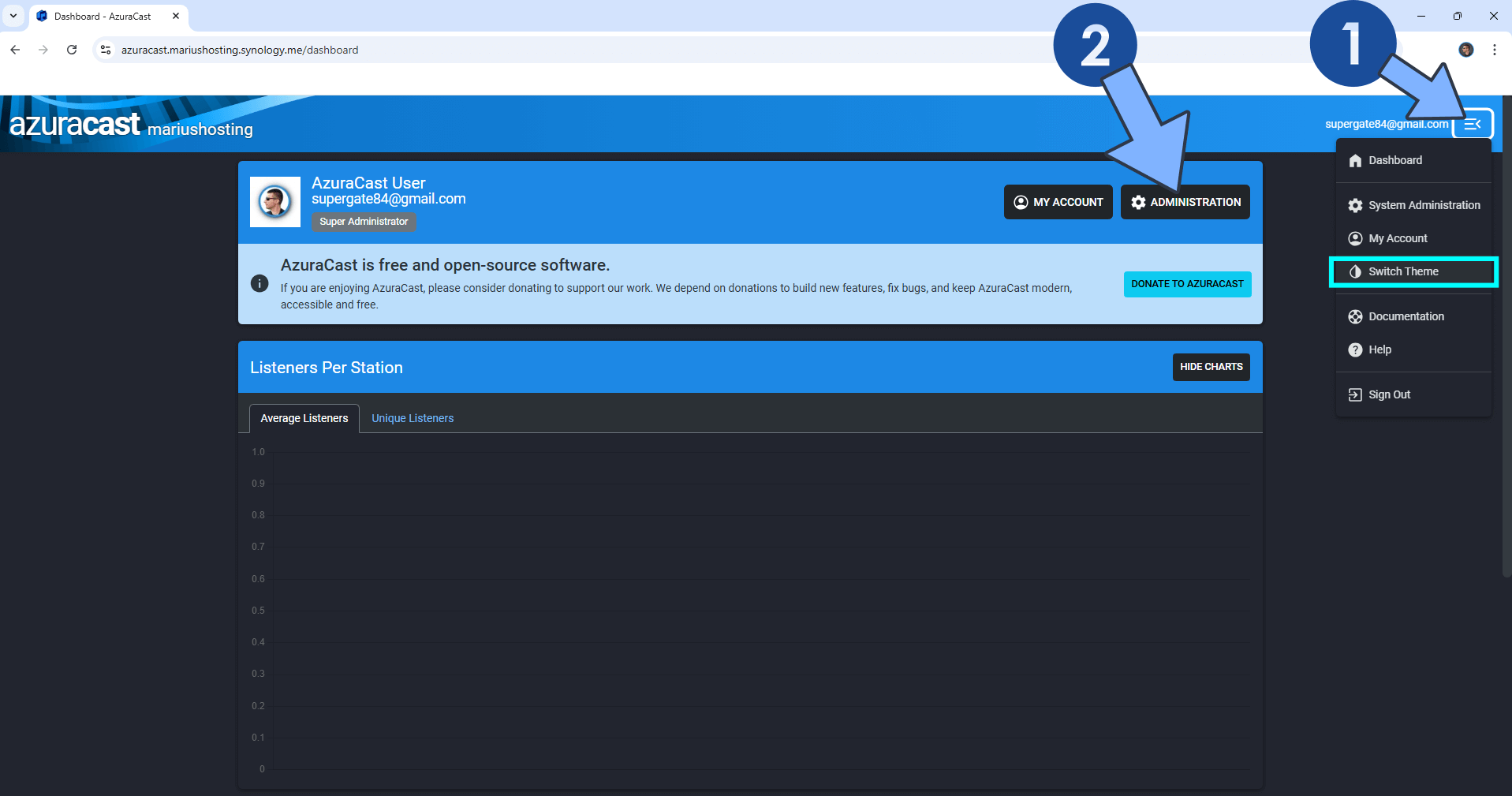
STEP 21
Your AzuraCast Radio Station dashboard at a glance!
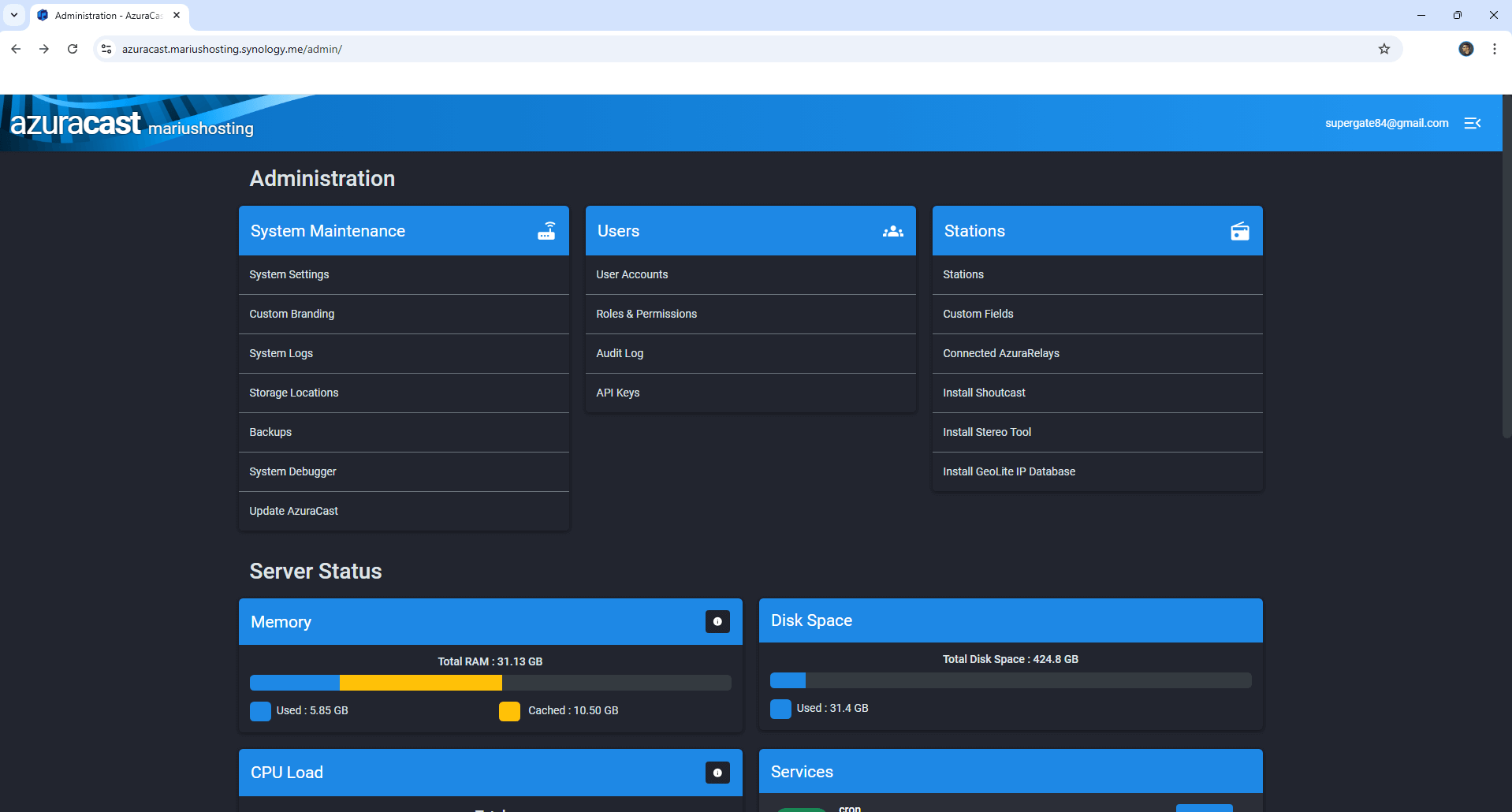
Enjoy AzuraCast!
If you encounter issues by using this container, make sure to check out the Common Docker issues article.
Note: Can I run Docker on my Synology NAS? See the supported models.
Note: How to Back Up Docker Containers on your Synology NAS.
Note: Find out how to update the AzuraCast container with the latest image.
Note: How to Free Disk Space on Your NAS if You Run Docker.
Note: How to Schedule Start & Stop For Docker Containers.
Note: How to Activate Email Notifications.
Note: How to Add Access Control Profile on Your NAS.
Note: How to Change Docker Containers Restart Policy.
Note: How to Use Docker Containers With VPN.
Note: Convert Docker Run Into Docker Compose.
Note: How to Clean Docker.
Note: How to Clean Docker Automatically.
Note: Best Practices When Using Docker and DDNS.
Note: Some Docker Containers Need WebSocket.
Note: Find out the Best NAS Models For Docker.
Note: Activate Gmail SMTP For Docker Containers.
This post was updated on Wednesday / June 4th, 2025 at 2:16 AM
